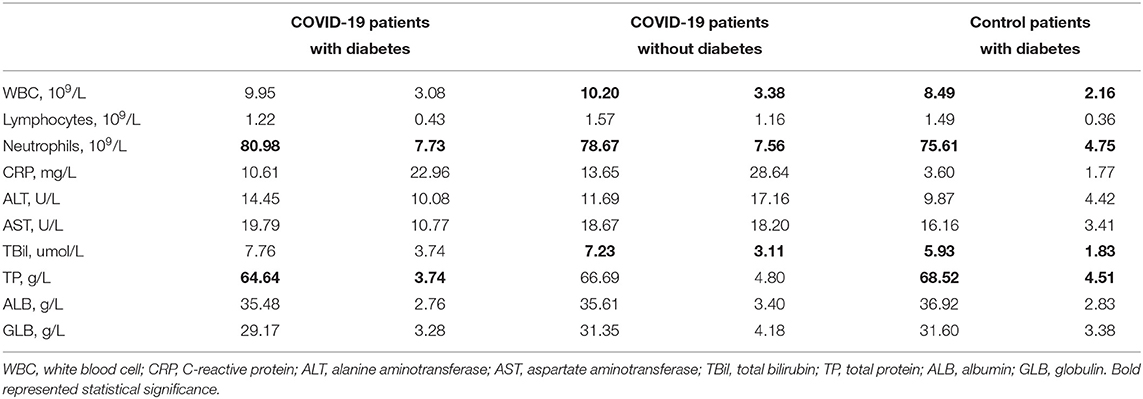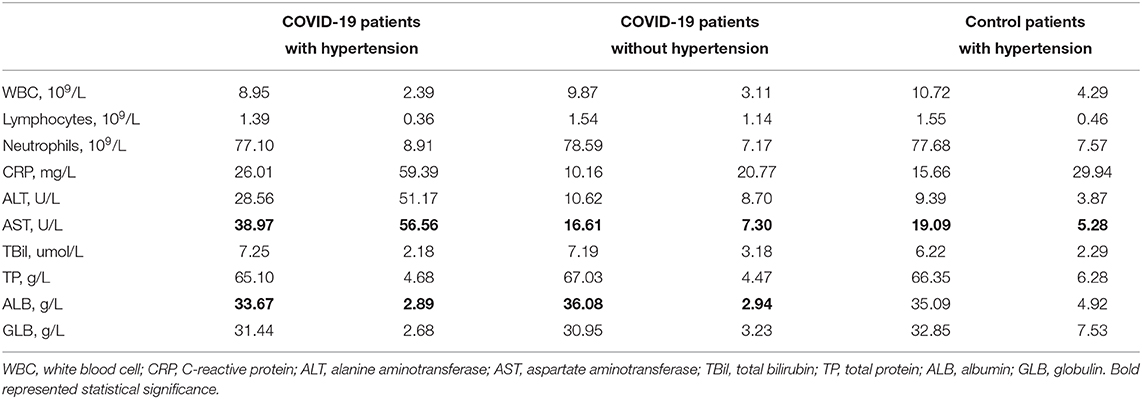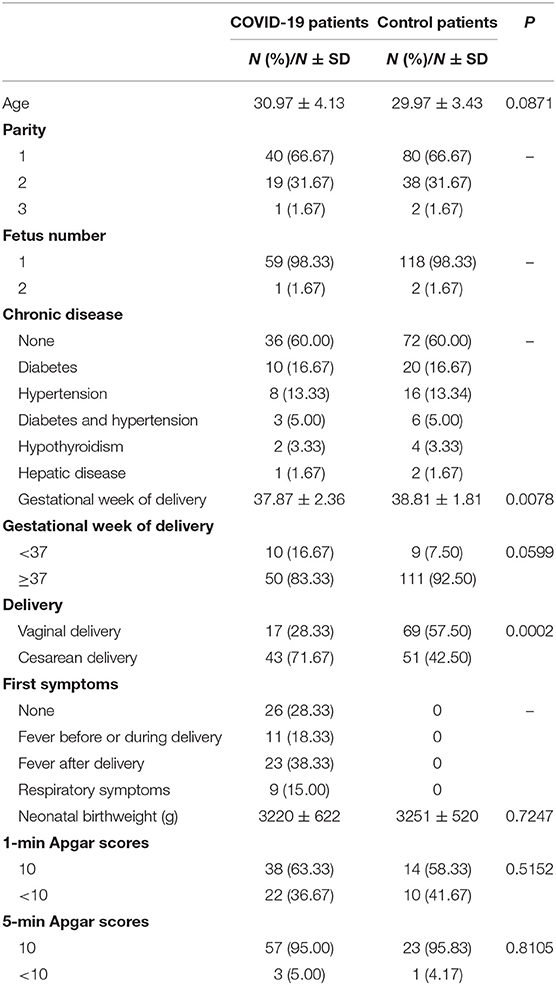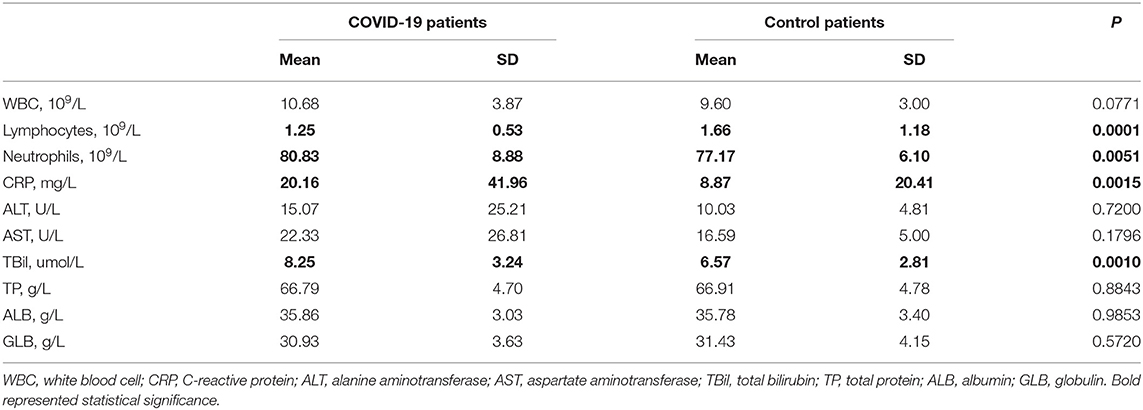- 1Obstetric Department, Maternal and Child Health Hospital of Hubei Province, Wuhan, China
- 2Longquanyi District of Chengdu Maternal and Child Health Care Hospital, Chengdu, China
Background: Coronavirus disease (COVID-19) is a current global public health emergency. However, current research on the blood test results of pregnant women with COVID-19 is insufficient.
Methods: A case-control study was carried out based on clinical blood test results. Pregnant COVID-19 patients, pregnant COVID-19 patients with diabetes, and pregnant COVID-19 patients with hypertension, were assessed in this study. Also, 120 controls were matched by age, parity, fetus number, and presence of chronic disease. T-tests, Chi-square tests, Wilcoxon signed-rank tests, and Kruskal-Wallis tests were used to compare data from the blood tests and liver function indices among the selected groups.
Results: Between January 24 and March 14, 2020, 60 pregnant COVID-19 patients delivered at the Maternal and Child Health Hospital of Hubei Province. The average maternal age of pregnant COVID-19 patients was 30.97 years and the mean gestational period was 37.87 weeks. 71.67% (43/60) of pregnant COVID-19 patients gave birth by cesarean delivery. In total, 21.67% (13/60) were diagnosed with diabetes and 18.33% (11/60) were diagnosed with hypertension during pregnancy. Compared to controls, pregnant COVID-19 patients showed significantly lower numbers of blood lymphocytes and higher numbers of neutrophils, as well as higher levels of C-reactive protein and total bilirubin. Among the three groups, pregnant COVID-19 patients with diabetes had significantly higher levels of neutrophils and lower levels of total protein. Aspartate transaminase levels were higher in pregnant COVID-19 patients with hypertension than in pregnant COVID-19 patients with no comorbidities and controls with hypertension.
Interpretations: Blood and liver function indices indicate that chronic complications, including hypertension and diabetes, could increase the risk of inflammation and liver injury in pregnant COVID-19 patients.
Introduction
SARS-CoV-2, which causes coronavirus disease (COVID-19), is a new coronavirus discovered in 2019. It is similar to previously studied zoonotic viruses, including the severe acute respiratory syndrome coronavirus (SARS-CoV-1) and the Middle East respiratory syndrome coronavirus (MERS-CoV) (Liu Y. et al., 2020). Since its first report in Wuhan, China in December 2019, over 3.8 million people have been infected with SARS-CoV-2, and it has caused over 260,000 deaths worldwide (Rothan and Byrareddy, 2020; World Health Organization, 2020). The World Health Organization (WHO) declared the SARS-CoV-2 outbreak to be a public health emergency of international concern on January 30, 2020, indicating a high global risk (Sohrabi et al., 2020).
To provide practical evidence for the prevention and control of COVID-19, many studies have been conducted on the general population. However, pregnant women are more vulnerable to COVID-19 because they are in an immunocompromised state (Liang and Acharya, 2020). Pneumonia arising from any infectious etiology is an important cause of morbidity and mortality among pregnant women (Schwartz and Graham, 2020). In addition, both hypertension and diabetes are common complications during pregnancy, which have long-term negative health impacts on both mothers and their offspring (Davenport et al., 2018). Thus, pregnant women, especially those with chronic complications, should be evaluated as a high-risk group during the current COVID-19 pandemic (Liu D. et al., 2020).
To date, most studies (Chen H. et al., 2020; Chen N. et al., 2020; Schwartz, 2020) on pregnant women with COVID-19 have described their clinical characteristics including symptoms, pregnancy outcomes, CT manifestation, and mother-child vertical transmission. However, the indication for the adoption of cesarean delivery was controversial at the beginning of COVID-19 epidemic because parturient with COVID-19 might be associated with increased risk of miscarriage, preterm birth, and neonatal death (Boelig et al., 2020; Chen Z. et al., 2020; Wu et al., 2020). And there are few studies assessing pregnant women with COVID-19 who have comorbidities including hypertension and diabetes. The purpose of this study was to compare blood test results and liver function indices among pregnant COVID-19 patients and control groups of ordinary pregnant women.
Methods
Participants
Patients included in the study delivered at the Maternity and Child Health Hospital in Wuhan, Hubei province. In 2018, 22.55% of newborns in Wuhan were delivered at this hospital, making it the largest maternal hospital in Hubei. From January 24 to March 14, 2020, 3,730 pregnant women delivered in this hospital, and 60 of them (1.61%) were confirmed to have COVID-19 by laboratory and clinical diagnosis (Juan et al., 2020). Moreover, we retrospectively selected 120 controls matched by age (within 3 years), parity, fetus number, and chronic disease (including diabetes, hypertension, hypothyroidism, and hepatic disease). Control patients were selected 1 year before the COVID-19 epidemic. Sociodemographic information and blood samples were collected upon admission and results were obtained from medical health records. All research subjects were recruited in the third trimester.
Data Analysis
Maternal and neonatal characteristics of continuous variables are presented as mean ± SD. T-tests, Chi-square tests, Wilcoxon signed-rank tests, and Kruskal-Wallis tests were used to compare the characteristics between the pregnant COVID-19 patients and control groups. Data analyses were conducted using the Statistical Analysis System (SAS 9.4). Two-sided p < 0.05 were considered statistically significant.
Results
Sociodemographic characteristics of pregnant COVID-19 patients and control groups are shown in Table 1. The average age of the pregnant COVID-19 patients was 30.97 years and the mean gestational period was 37.87 weeks. These patients presented with mild COVID-19 infection. A high percentage of diabetes and hypertension was detected among the pregnant COVID-19 patients (21.67 and 18.34%, respectively). The majority of pregnant patients gave birth by cesarean delivery (71.67%), significantly higher than that of control groups (42.50%). Most pregnant COVID-19 patients showed no fever or respiratory symptoms, and only 15% reported respiratory symptoms during hospitalization. There were 61 live-birth newborns without COVID-19 infection. Moreover, Table S1 presents the characteristics of maternal COVID-19 patients with chronic disease. The difference of clinical symptoms showed no statistical significance between pregnant COVID-19 patients with chronic disease and COVID-19 patients without chronic disease. Cesarean delivery in COVID-19 patients with chronic was significantly higher than in COVID-19 patients without chronic disease (91.67 vs. 58.33%, p = 0.0054).
Blood test results of the study groups are presented in Table 2. There was a statistically significant difference in the number of blood lymphocytes, neutrophils, and C-reactive protein (CRP) between pregnant COVID-19 patients and control women. Moreover, blood total bilirubin (TBil) levels in pregnant COVID-19 patients were significantly higher than those in controls (8.25 vs. 6.57, p < 0.05). The results of Chi-square analysis further confirmed that the proportion of lymphocytopenia among COVID-19 patients was significantly higher than control groups (43.33 vs. 15.83%, p = 0.0003) (Table S2). The proportion of COVID-19 patients with elevated CRP was higher than the control groups (60.00 vs. 38.33%, p = 0.0061). The blood test results of liver function showed that the proportion of COVID-19 patients with elevated aspartate aminotransferase (AST) was higher than the ordinary patients (8.33 vs. 0.83%, p = 0.0084). Moreover, the proportion of COVID-19 patients with decreased blood TBil level was lower than the control groups (11.67 vs. 29.17%, p = 0.0091).
Blood test results of pregnant COVID-19 patients and controls with diabetes are presented in Table 3. The white blood cell (WBC) count of pregnant COVID-19 patients without diabetes was significantly higher than that in the pregnant controls with diabetes (10.20 vs. 8.49, p < 0.05). The number of neutrophils in pregnant COVID-19 patients with diabetes was higher than that in both pregnant COVID-19 patients without chronic disease and controls with diabetes (80.98 vs. 78.67 and 75.61, respectively, p < 0.05). The TBil level in COVID-19 patients without diabetes was higher than that in pregnant controls with diabetes (7.23 vs. 5.93, p < 0.05). Finally, total protein (TP) levels in the pregnant COVID-19 patients with diabetes were significantly lower than that in the controls with diabetes (64.64 vs. 68.52, p < 0.05). Table S3 shows that the proportion of participants with decreased albumin (ALB) was higher than the ordinary patients with diabetes (46.15 vs. 19.23%, p = 0.042).

Table 3. Blood test results of pregnant COVID-19 patients and control pregnant patients with diabetes.
Blood test results of pregnant COVID-19 patients and controls with hypertension are presented in Table 4. WBC, lymphocytes, neutrophils, and CRP were unchanged across the different groups. In contrast, AST levels in pregnant COVID-19 patients with hypertension were significantly higher than that in pregnant COVID-19 patients without chronic disease and controls with hypertension (38.97 vs. 16.61 and 19.09, respectively, p < 0.05). Additionally, ALB levels in pregnant COVID-19 patients with hypertension were significantly lower than that in pregnant COVID-19 patients without hypertension (33.67 vs. 36.08, p < 0.05). Table S4 shows that the proportion of lymphocytopenia of COVID-19 patients with hypertension was significantly higher than that of control patients with hypertension (18.18% vs. 9.09, p = 0.049).

Table 4. Blood test results of pregnant COVID-19 patients and control pregnant patients with hypertension.
Discussion
This is an updated case-control study comparing the blood test results of pregnant women with COVID-19. Among the pregnant COVID-19 patients, there were 43 of 60 cases (71.67%) underwent cesarean section. This result is in line with previous studies which reported a range of 56–93% of cesarean section (Chen L. et al., 2020; Huntley et al., 2020; Walker et al., 2020; Yang et al., 2020). The high adoption of cesarean delivery might be partly explained by the COVID-19 infection combined with the presents of chronic disease and the concern about the effects of COVID-19 on the pregnancy. We found that the most prevalent symptom of pregnant COVID-19 patients was fever, and a majority had no respiratory symptoms. These findings are consistent with other studies (Chen L. et al., 2020; Guan et al., 2020). Zaigham and Andersson (2020) also reported that most COVID-19 patients did not have any symptoms upon admission. Therefore, it is necessary to separate COVID-19 infected patients from ordinary patients by laboratory indicators upon hospital admission. Moreover, maternal symptoms of COVID-19 during the first or second trimester of pregnancy require further research.
This study showed a high percentage of diabetes and hypertension among pregnant COVID-19 patients. A previous study based on 30 pregnant COVID-19 patients confirmed that the most common comorbidities were hypertension (16.7%) and diabetes (6.6%) (Wang et al., 2020). The associations between COVID-19 infection and the development of diabetes and hypertension among pregnant women were still unclear. The potential mechanism might be explained by the expression of Angiotensin-converting-enzyme 2 (ACE2), the receptor for the COVID-19 spike protein, on pancreatic β cells can have a direct effect on β cell function, which might result in the development of diabetes among pregnant COVID-19 patients (Bornstein et al., 2020). Moreover, the hyper-inflammatory state in COVID-19 may be associated with a higher risk of developing pre-eclampsia (Abbas et al., 2020).
As far as we know, this is the first study to explore the blood test results of pregnant women with chronic disease who are diagnosed with COVID-19. Compared to the pregnant women without COVID-19, the blood indices of pregnant COVID-19 patients showed a significantly lower lymphocyte count than the controls. Other indices including neutrophil count and CRP levels of the pregnant COVID-19 patients were significantly higher than those of the control pregnant women. These differences in inflammatory indices are in accordance with typical clinical characteristics of pneumonia. Chen L. et al. (2020) reported that lymphopenia was present in 51 of 116 pregnant women diagnosed with COVID-19, while. Liu D. et al. (2020) found that among 15 pregnant COVID-19 patients, 12 had a decreased lymphocyte count and 10 had increased CRP values. It is recommended that the blood indices of pregnant COVID-19 patients should be carefully monitored and the changes in these inflammatory indices were correlated with the prognosis of patients (Chen L. et al., 2020). The long-term effects of the COVID-19 infection and treatment on blood indices of pregnant COVID-19 patients need further study.
Additionally, pregnant women with COVID-19 showed significantly higher TBil values. Elevated TBil levels are considered biomarkers for liver disease (Weaver et al., 2018). Thus, COVID-19 could affect the liver function of pregnant women. However, there was no difference in ALT and AST levels in pregnant women with COVID-19. A cohort study (Guan et al., 2020) containing 1,099 COVID-19 cases showed that 10.5% of patients presented with abnormal bilirubin, 21.3% with ALT elevation, and 22.2% with AST elevation. It has been reported that 2–11% of patients with COVID-19 have liver comorbidities and 14–53% have abnormal levels of AST and ALT during disease progression (Zhang et al., 2020). The limited number of pregnant COVID-19 patients in this study may limit the power to detect changes in ALT and AST. Moreover, the majority of the COVID-19 patients in this study had a mild infection and liver injury was not obvious. Therefore, liver damage caused by COVID-19 during pregnancy is still unclear and needs further research.
In our study, pregnant COVID-19 patients with chronic diseases, including diabetes or hypertension, showed a stronger inflammation response and markers of liver injury compared to pregnant COVID-19 patients without chronic diseases and control pregnant women with chronic diseases. Compared to the other two groups, pregnant COVID-19 patients with diabetes had significantly higher neutrophil counts and lower TP values. The main feature of diabetes is hyperglycemia, which can increase the oxidative stress response and enhance the inflammatory response. Diabetes could also compromise the ability of the liver to regenerate (Mendes-Braz and Martins, 2018). Insulin resistance in diabetes influences liver cell apoptosis and causes liver dysfunction (Schattenberg and Schuchmann, 2009). Hajam and Rai (2019) found that diabetic rats had a significant increase in lipid peroxidation (LPO) in the liver, while ALT, AST, and ALP levels were significantly decreased in the antioxidative enzymatic system. Thus, under the combined effects of COVID-19 and diabetes, suboptimal inflammatory processes and liver function biomarkers might indicate a worse prognosis in pregnant women.
Moreover, pregnant COVID-19 patients with hypertension showed a significantly higher level of blood AST, which is an important indicator of liver function (Sookoian and Pirola, 2015). Arima et al. (2014) reported that hypertension exacerbated liver injury and hepatic fibrosis in spontaneously hypertensive rats. Han et al. (2015) revealed that trophoblastic mitochondrial damage may result in liver injury in preeclampsia-like mouse models. Therefore, it was hypothesized that pregnant COVID-19 patients with hypertension are more likely to suffer from liver injury than the other groups. However, few studies have focused on liver injury caused by hypertension and this hypothesis requires further verification.
Our study has several limitations. First, pregnant women with COVID-19 were only enrolled during their third trimester. The effects of COVID-19 on pregnant women in their first or second trimester are not clear. Second, this study only assessed pregnant COVID-19 patients during hospitalization, but long-term effects on the liver and other organs as well as newborns require further research. Third, we only compared the blood indices of pregnant COVID-19 patients with hypertension and diabetes. The mechanisms underlying the effects of COVID-19 on these parameters also need further exploration.
Conclusion
The results of this study indicate that chronic diseases may strengthen the inflammatory response to COVID-19 and mediate liver damage in pregnant women. Therefore, during the treatment of pregnant women with COVID-19, focusing on inflammation and liver injury is necessary, especially for those with chronic diseases.
Data Availability Statement
The datasets generated for this article are not readily available because The application of the raw data should be approved by the Ethics Committee of Maternal and Child Health Hospital of Hubei Province. Requests to access the datasets should be directed to Yao Cheng, Y2hlbmd5YW8yMDE0QHNpbmEuY29t.
Ethics Statement
The studies involving human participants were reviewed and approved by Medical Ethics Committee of Maternal and Child Health Care Hospital of Hubei Province. Written informed consent for participation was not required for this study in accordance with the national legislation and the institutional requirements.
Author Contributions
GS, YC, and QL: wrote the manuscript. GS, YC, and YZ: conceived and designed the experiments. YC: analyzed the data and performed the experiments. All of the authors: gave final approval of the version to be submitted and agree to be accountable for all aspects of the work.
Conflict of Interest
The authors declare that the research was conducted in the absence of any commercial or financial relationships that could be construed as a potential conflict of interest.
Acknowledgments
We would like to express our gratitude to all the medical staff of the Department of Obstetrics for their responsible work during the COVID-19 epidemic to ensure the safety of maternal inpatients.
Supplementary Material
The Supplementary Material for this article can be found online at: https://www.frontiersin.org/articles/10.3389/fcimb.2020.560899/full#supplementary-material
Abbreviations
CRP, C-reactive protein; TBil, total bilirubin; TP, total protein; ALT, alanine aminotransferase; AST, aspartate aminotransferase; WBC, white blood cell; ALB, albumin; GLB, globulin.
References
Abbas, A. M., Ahmed, O. A., and Shaltout, A. S. (2020). COVID-19 and maternal pre-eclampsia; a synopsis. Scand. J. Immunol. 15:e12918. doi: 10.1111/sji.12918
Arima, S., Uto, H., Ibusuki, R., Kumamoto, R., Tanoue, S., Mawatari, S., et al. (2014). Hypertension exacerbates liver injury and hepatic fibrosis induced by a choline-deficient L-amino acid-defined diet in rats. Int. J. Mol. Med. 33, 68–76. doi: 10.3892/ijmm.2013.1544
Boelig, R. C., Manuck, T., Oliver, E. A., Di-Mascio, D., Saccone, G., Bellussi, F., et al. (2020). Labor and delivery guidance for COVID-19. Am. J. Obstet. Gynecol. MFM 2:100110. doi: 10.1016/j.ajogmf.2020.100110
Bornstein, S. R., Rubino, F., Khunti, K., Mingrone, G., Hopkins, D., and Birkenfeld, A. L. (2020) Practical recommendations for the management of diabetes in patients with COVID-19. Lancet. Diabetes Endocrinol. 8, 546–550. doi: 10.1016/S2213-8587(20)30152-2.
Chen, H., Guo, J. J., Wang, C., Luo, F., Yu, X. C., Zhang, W., et al. (2020). Clinical characteristics and intrauterine vertical transmission potential of COVID-19 infection in nine pregnant women: a retrospective review of medical records. Lancet 395, 809–815. doi: 10.1016/S0140-6736(20)30360-3
Chen, L., Li, Q., Zheng, D., Jiang, H., Wei, Y., Zou, L., et al. (2020). Clinical characteristics of pregnant women with Covid-19 in Wuhan, China. N. Engl. J. Med. 382:e100. doi: 10.1056/NEJMc2009226
Chen, N., Zhou, M., Dong, X., Qu, J., Gong, F., Han, Y., et al. (2020). Epidemiological and clinical characteristics of 99 cases of 2019 novel coronavirus pneumonia in Wuhan, China: a descriptive study. Lancet 395, 507–513. doi: 10.1016/S0140-6736(20)30211-7
Chen, Z., Ma, X., and Wang, S. (2020). Delivery method choice for COVID-19 pregnant women: stick to obstetric indications and avert anorectum contamination. Am. J. Obstet. Gynecol. 223, 612–613. doi: 10.1016/j.ajog.2020.06.013
Davenport, M. H., Ruchat, S. M., Poitras, V. J., Jaramillo-Garcia, A., Gray, C. E., Barrowman, N., et al. (2018). Prenatal exercise for the prevention of gestational diabetes mellitus and hypertensive disorders of pregnancy: a systematic review and meta-analysis. Br. J. Sports Med. 52, 1367–1375. doi: 10.1136/bjsports-2018-099355
Guan, W. J., Ni, Z. Y., Hu, Y., Liang, W. H., Ou, C. Q., He, J. X., et al. (2020). Clinical characteristics of coronavirus disease 2019 in China. N. Engl. J. Med. 80, 656–665. doi: 10.1056/NEJMoa2002032
Hajam, Y. A., and Rai, S. (2019). Melatonin and insulin modulates the cellular biochemistry, histoarchitecture and receptor expression during hepatic injury in diabetic rats. Life Sci. 239:117046. doi: 10.1016/j.lfs.2019.117046
Han, Y. W., Yang, Z., Ding, X. Y., and Yu, H. (2015). Differences in liver injury and trophoblastic mitochondrial damage in different preeclampsia-like mouse models. Chin. Med. J. 128, 1627–1635. doi: 10.4103/0366-6999.158322
Huntley, B. J. F., Huntley, E. S., Di-Mascio, D., Chen, T., Berghella, V., and Chauhan, S. P. (2020). Rates of maternal and perinatal mortality and vertical transmission in pregnancies complicated by severe acute respiratory syndrome Coronavirus 2 (SARS-Co-V-2) infection: a systematic review. Obstet. Gynecol. 136, 303–312. doi: 10.1097/AOG.0000000000004010
Juan, J., Gil, M. M., Rong, Z., Zhang, Y., Yang, H., and Poon, L. C. (2020). Effects of coronavirus disease 2019 (COVID-19) on maternal, perinatal and neonatal outcomes: a systematic review. Ultrasound Obstet. Gynecol. 56, 15–27. doi: 10.1002/uog.22088
Liang, H., and Acharya, G. (2020). Novel corona virus disease (COVID-19) in pregnancy: what clinical recommendations to follow? Acta Obstet. Gynecol. Scand. 99, 439–442. doi: 10.1111/aogs.13836
Liu, D., Li, L., Wu, X., Zheng, D., Wang, J., Yang, L., et al. (2020). Pregnancy and perinatal outcomes of women with coronavirus disease (COVID-19) pneumonia: a preliminary analysis. AJR Am J Roentgenol. 215, 127–132. doi: 10.2214/AJR.20.23072
Liu, Y., Gayle, A. A., Wilder-Smith, A., and Rocklov, J. (2020). The reproductive number of COVID-19 is higher compared to SARS coronavirus. J. Travel Med. 27:taaa021. doi: 10.1093/jtm/taaa021
Mendes-Braz, M., and Martins, J. O. (2018). Diabetes mellitus and liver surgery: the effect of diabetes on oxidative stress and inflammation. Mediators Inflamm. 2018:2456579. doi: 10.1155/2018/2456579
Rothan, H. A., and Byrareddy, S. N. (2020). The epidemiology and pathogenesis of coronavirus disease (COVID-19) outbreak. J. Autoimmun. 109:102433. doi: 10.1016/j.jaut.2020.102433
Schattenberg, J. M., and Schuchmann, M. (2009). Diabetes and apoptosis: liver. Apoptosis 14, 1459–1471. doi: 10.1007/s10495-009-0366-2
Schwartz, D. A. (2020). An analysis of 38 pregnant women with COVID-19, their newborn infants, and maternal-fetal transmission of SARS-CoV-2: maternal coronavirus infections and pregnancy outcomes. Arch. Pathol. Lab. Med. 144, 799–805. doi: 10.5858/arpa.2020-0901-SA
Schwartz, D. A., and Graham, A. L. (2020). Potential maternal and infant outcomes from (Wuhan) coronavirus 2019-nCoV infecting pregnant women: lessons from SARS, MERS, and other human coronavirus infections. Viruses 12:94. doi: 10.3390/v12020194
Sohrabi, C., Alsafi, Z., O'neill, N., Khan, M., Kerwan, A., Al-Jabir, A., et al. (2020). World Health Organization declares global emergency: a review of the 2019 novel coronavirus (COVID-19). Int. J. Surg. 76, 71–76. doi: 10.1016/j.ijsu.2020.02.034
Sookoian, S., and Pirola, C. J. (2015). Liver enzymes, metabolomics and genome-wide association studies: from systems biology to the personalized medicine. World J. Gastroenterol. 21, 711–725. doi: 10.3748/wjg.v21.i3.711
Walker, K. F., O'Donoghue, K., Grace, N., Dorling, J., Comeau, J. L., Li, W., et al. (2020). Maternal transmission of SARS-COV-2 to the neonate, and possible routes for such transmission: a systematic review and critical analysis. BJOG 127, 1324–1336. doi: 10.1111/1471-0528.16362
Wang, Z., Wang, Z., and Xiong, G. (2020). Clinical characteristics and laboratory results of pregnant women with COVID-19 in Wuhan, China. Int. J. Gynaecol. Obstet. 150, 312–317. doi: 10.1002/ijgo.13265
Weaver, L., Hamoud, A. R., Stec, D. E. D, and Hinds, T. D. J. (2018). Biliverdin reductase and bilirubin in hepatic disease. Am. J. Physiol. Gastrointest. Liver Physiol. 314, G668–G676. doi: 10.1152/ajpgi.00026.2018
World Health Organization (2020). COVID-19. Available online at: https://covid19.who.int/ (accessed 10 May, 2020).
Wu, Y., Liu, C., Dong, L., Zhang, C., Chen, Y., Liu, J., et al. (2020). Coronavirus disease 2019 among pregnant Chinese women: case series data on the safety of vaginal birth and breastfeeding. BJOG. 127, 1109–1115. doi: 10.1111/1471-0528.16276
Yang, Z., Wang, M., Zhu, Z., and Liu, Y. (2020). Coronavirus disease 2019 (COVID-19) and pregnancy: a systematic review. J. Matern. Fetal Neonatal Med. 30, 1–4. doi: 10.1080/14767058.2020.1759541
Zaigham, M., and Andersson, O. (2020). Maternal and perinatal outcomes with COVID-19: A systematic review of 108 pregnancies. Acta Obstet. Gynecol. Scand. 99, 823–829. doi: 10.1111/aogs.13867
Keywords: COVID-19, blood lab test, case-control, pregnancy with hypertension, pregnancy with diabetes
Citation: Sun G, Zhang Y, Liao Q and Cheng Y (2020) Blood Test Results of Pregnant COVID-19 Patients: An Updated Case-Control Study. Front. Cell. Infect. Microbiol. 10:560899. doi: 10.3389/fcimb.2020.560899
Received: 11 May 2020; Accepted: 20 August 2020;
Published: 07 October 2020.
Edited by:
Ran Nir-Paz, Hebrew University of Jerusalem, IsraelReviewed by:
Doron Kabiri, Hebrew University Hadassah Medical School, IsraelDrorith Celnikier Hochner, Hadassah Medical Center, Israel
Copyright © 2020 Sun, Zhang, Liao and Cheng. This is an open-access article distributed under the terms of the Creative Commons Attribution License (CC BY). The use, distribution or reproduction in other forums is permitted, provided the original author(s) and the copyright owner(s) are credited and that the original publication in this journal is cited, in accordance with accepted academic practice. No use, distribution or reproduction is permitted which does not comply with these terms.
*Correspondence: Yao Cheng, Y2hlbmd5YW8yMDE0QHNpbmEuY29t; Qing Liao, bGlhb3Fpbmc5NEAxNjMuY29t
†These authors have contributed equally to this work
 Guoqiang Sun1
Guoqiang Sun1 Qing Liao
Qing Liao Yao Cheng
Yao Cheng
